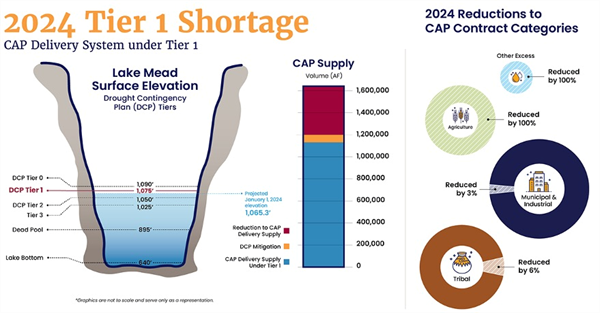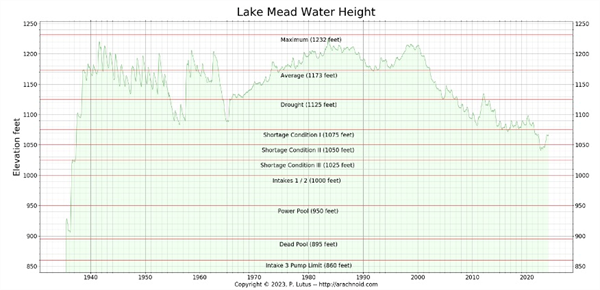
In 2023 Arizona and the lower basin states were operating under Tier 2 reductions, consistent with the Drought Contingency Plans (DCP) for Colorado River conservation in response to the drought conditions (Figure 1). Tier 2 conditions imposed a 592,000 acre-feet (kaf) reduction in Arizona’s 2.8 million acre-feet (maf) total allocation from the Colorado River. These reductions have primarily impacted the irrigation districts in central Arizona.
For 2024, the Bureaus of Reclamation (BoR) has announced in August 2023 that the river operations will follow Tier 1 DCP reductions (Figure 1). That is due to an increase in the water levels in Lake Mead in the past year with an excellent snowpack last winter and above average runoff in 2023. That increase in water level at Hoover Dam in Lake Mead is primarily a function of an excellent snowpack and higher rainfall in the Colorado River basin in 2023. Significant conservation efforts have been employed as well.

Figure 1. 2024 Tier 1 Shortage for the Colorado River operations. Source:
Arizona Department of Water Resources.
With agriculture responsible for 70% of the diversions on the Colorado River, tracking the snowpack is an important exercise for forecasting and managing the precious water resources in this region and this watershed for sure.
The pressures on the Colorado River system because of the drought that has been impacting the entire basin and region for 23 years have slackened briefly due to the wet winter in 2023 with a good snowpack in the mountains, good rainfall throughout the basin, good flows into the river, and conservation.
The current water level at Lake Mead on Hoover Dam is 1,068.25 ft. above sea level on 3 January 2024. That level is 160.75 ft below full pool of 1,229.00 ft. (Figure 2).

Figure 2. Lake Mead water height (feet above sea level at Hoover Dam) history
and critical Tier conditions. Source: U.S. Bureau of Reclamation.
The current snowpack in the Colorado River Basin is at 74% of average and below levels of this time last year. However, hydrological records indicate that most of the snowpack in this basin accumulates between February and April.
So, it is worth watching the snowpack accumulation and it is always good to pray for more snow in mountains to the north for those of us working and living in this desert with a heavy dependence on this water. However, while monitoring the snowpack gives us a capacity to project, none of that really counts until there is water in the river and in the reservoirs, like money in the bank.
This study was conducted at the Yuma Valley Agricultural Center. The soil was a silty clay loam (7-56-37 sand-silt-clay, pH 7.2, O.M. 0.7%). Spinach ‘Meerkat’ was seeded, then sprinkler-irrigated to germinate seed Jan 13, 2025 on beds with 84 in. between bed centers and containing 30 lines of seed per bed. All irrigation water was supplied by sprinkler irrigation. Treatments were replicated four times in a randomized complete block design. Replicate plots consisted of 15 ft lengths of bed separated by 3 ft lengths of nontreated bed. Treatments were applied with a CO2 backpack sprayer that delivered 50 gal/acre at 40 psi to flat-fan nozzles.

Downy mildew (caused by Peronospora farinosa f. sp. spinaciae)was first observed in plots on Mar 5 and final reading was taken on March 6 and March 7, 2025. Spray date for each treatments are listed in excel file with the results.
Disease severity was recorded by determining the percentage of infected leaves present within three 1-ft2areas within each of the four replicate plots per treatment. The number of spinach leaves in a 1-ft2area of bed was approximately 144. The percentage were then changed to 1-10scale, with 1 being 10% infection and 10 being 100% infection.
The data (found in the accompanying Excel file) illustrate the degree of disease reduction obtained by applications of the various tested fungicides. Products that provided most effective control against the disease include Orondis ultra, Zampro, Stargus, Cevya, Eject .Please see table for other treatments with significant disease suppression/control. No phytotoxicity was observed in any of the treatments in this trial.
Presentation given at 2021 ASABE Annual International Meeting on the development and evaluation of a novel, band steam applicator for controlling soilborne pathogens and weeds in lettuce. Band-steam is where steam is used to heat narrow strips of soil to levels sufficient to kill soilborne pathogens and weeds (140 °F for 20 minutes). Development of a band-steam applicator that applies steam in 4" wide by 2" deep band centered on the seedline is presented. Two trials investigating the use of band-steam for controlling Sclerotinia lettuce drop and weeds in lettuce were conducted. Trial results were promising. Highlights included finding that treatment with steam provided better than 85% weed control, and the unexpected result that crop yields were improved by more than 24%. Energy requirements were high and treatment costs were more than $650/acre. Band-steam may be a viable technique for controlling soilborne pests in high value vegetable crops such as lettuce if the significant yield increases found in this study can be realized.
To watch presentation click: A Novel Band-Steam Applicator
When I think about Lipid Biosynthesis Inhibitor herbicides, Post (sethoxidim) and Select (clethodim) come to my mind. A great description of these type of herbicides can be found at the Section VI of the Arizona Pest Control Advisor (PCA) Study Guide. They say a good teacher can explain complicated things in a simple way. Please read this explanation by Barry Tickes:
“These herbicides are known as ACCase inhibitors because they inhibit the production of acetyl-coenzyme A carboxylase (ACCase) which is an enzyme needed in the first steps of lipid or fatty acid production. Lipids are needed in the production of new membranes which, among other things, are needed in the production of cell walls. These chemicals move from the foliage to the growing points, only kill grasses, and have very little soil activity. Grasses stop growing immediately and slowly turn chlorotic or red and die usually in 7 to 21 days. These products are used to selectively kill grasses in broadleaf crops".
|
Classification |
Common |
Commercial |
Arizona crop |
|
Aryloxphenoxy |
fluazifop |
Fusilade |
Small grains, |
|
Cyclohexanediones |
sethoxydim |
Poast, Segment, |
Alfalfa, cotton, |
You need to see this .. time lapse photography shows the symptoms of Poast herbicide to wheat.
Results of pheromone and sticky trap catches can be viewed here.
Corn earworm: CEW moth counts down in all traps over the last month; about average for December.
Beet armyworm: Moth trap counts decreased in all areas in the last 2 weeks but appear to remain active in some areas, and average for this time of the year.
Cabbage looper: Moths increased in the past 2 weeks, and average for this time of the season.
Diamondback moth: Adults increased in several locations last, particularly in the Yuma Valley most traps. Below average for December.
Whitefly: Adult movement remains low in all areas, consistent with previous years
Thrips: Thrips adult movement continues to decline, overall activity below average for December.
Aphids: Winged aphids still actively moving but declined movement in the last 2 weeks. About average for December.
Leafminers: Adult activity down in most locations, below average for this time of season.